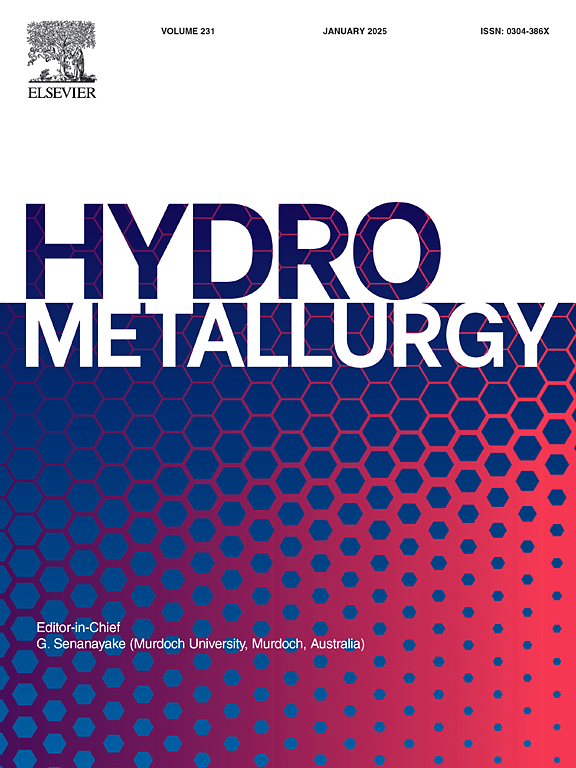利用报废钕铁硼磁铁废料制备高纯度氧化铁
IF 4.8
2区 材料科学
Q1 METALLURGY & METALLURGICAL ENGINEERING
引用次数: 0
摘要
报废钕铁硼磁铁废料中的酸溶性残渣通常会被引入黑色冶金工艺,以回收氧化铁作为增值产品,但这种方法的经济价值较低。本研究以钕铁硼磁体废料中含有稀土元素的氯化亚铁溶液为原料,该溶液是从酸溶性残渣中经过浸出和除杂工艺得到的。研究了氧化沉淀过程中的结晶机理和反应动力学,以制备高纯度氧化铁。结果表明,奥斯特瓦尔德熟化理论可以解释表面光滑、形态均匀的γ-FeOOH薄片的生长。亚铁氧化沉淀反应的表观活化能为 56.8 kJ/mol,表明这是一种化学控制反应。在最佳氧化沉淀条件下,亚铁离子和稀土元素的沉淀效率分别为 98.8 % 和 < 1 %。沉淀产物是结晶良好的γ-FeOOH,具有聚集片状形态。在 700 °C 下焙烧 2 小时后,得到纯度为 99.6 % 的氧化铁产品。这项研究可为有价值地利用钕铁硼磁铁废料中的酸溶性残留物提供技术支持,并为利用其他铁废料和残留物提出新方法。本文章由计算机程序翻译,如有差异,请以英文原文为准。
Preparation of high-purity iron oxide from end-of-life NdFeB magnet waste
The acid-soluble residue from end-of-life NdFeB magnet waste is often introduced into the ferrous metallurgical process to recover iron oxide as a value added product, but this approach has a low economic value. In this work, a ferrous chloride solution from NdFeB magnet waste containing rare earth elements, which was obtained after the leaching and impurity removal process from the acid-soluble residue, was used as the raw material. The crystallization mechanism and reaction kinetics in the oxidation precipitation process were studied to prepare high-purity iron oxide. The results showed that the growth of γ-FeOOH flakes with smooth surfaces and uniform morphologies could be explained by Ostwald's ripening theory. The apparent activation energy of the oxidative precipitation reaction of ferrous iron was 56.8 kJ/mol, indicating a chemically controlled reactions. Under the optimal oxidative precipitation conditions, the precipitation efficiency of ferrous ions and rare earth elements was 98.8 % and < 1 %, respectively. The precipitated product was well-crystallized γ-FeOOH with an aggregated flake morphology. It was roasted at 700 °C for 2 h to obtain an iron oxide product with a purity of 99.6 %. This study could provide technical support for the valuable utilization of acid-soluble residues from NdFeB magnet waste and to propose new methods for the utilization of other iron wastes and residues.
求助全文
通过发布文献求助,成功后即可免费获取论文全文。
去求助
来源期刊

Hydrometallurgy
工程技术-冶金工程
CiteScore
9.50
自引率
6.40%
发文量
144
审稿时长
3.4 months
期刊介绍:
Hydrometallurgy aims to compile studies on novel processes, process design, chemistry, modelling, control, economics and interfaces between unit operations, and to provide a forum for discussions on case histories and operational difficulties.
Topics covered include: leaching of metal values by chemical reagents or bacterial action at ambient or elevated pressures and temperatures; separation of solids from leach liquors; removal of impurities and recovery of metal values by precipitation, ion exchange, solvent extraction, gaseous reduction, cementation, electro-winning and electro-refining; pre-treatment of ores by roasting or chemical treatments such as halogenation or reduction; recycling of reagents and treatment of effluents.
 求助内容:
求助内容: 应助结果提醒方式:
应助结果提醒方式:


